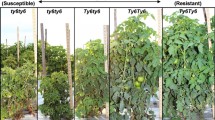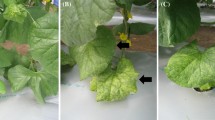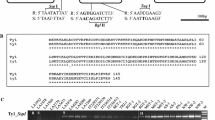Abstract
The whitefly-transmitted tomato yellow-leaf curl gemini-virus (TYLCV) is a major pathogen of tomatoes. The wild tomato species Lycopersicon chilense, which is resistant to the virus, was crossed to the cultivated tomato, L. esculentum. The backcross-1 selfed (BC1S1) generation was inoculated and a symptomless plant was selected. This plant was analyzed using 61 molecular markers, which span the tomato genome, to determine which L. chilense chromosome segments were introgressed. A BC2S1 population was cage-inoculated with viroliferous whiteflies (Bemisia tabaci), the natural insect vector of the virus, and subjected to RFLP analysis. Markers on chromosomes 3 and 6 were significantly associated with the level of tolerance; the association of chromosome-6 markers was further substantiated in two additional BC2S1 populations. A tolerant BC2S1 plant which was homozygous for L. chilense introgressions in chromosomes 3, 6 and 7 was crossed to generate a BC3S1 population which was planted in an infested field. A TYLCV-tolerance gene with partial dominance, TY-1, was mapped to chromosome 6; two modifier genes were mapped to chromosomes 3 and 7. Field and whitefly-mediated cage inoculations of nearly-isogenic lines in BC3S3 supported our conclusion that TY-1 is the major TYLCV-tolerance locus.
Similar content being viewed by others
References
Behare J, Laterrot H, Sarfatti M, Zamir D (1991) RFLP mapping of the Stemphylium resistance gene in tomato. Mol Plant-Microbe Interact 4:489–492
Bournival BL, Vallejos CE, Scott JW (1989) An isozyme marker for resistance to race 3 of Fusarium oxysporum f. sp. lycopersici in tomato. Theor Appl Genet 78:489–494
Brown JK, Nelson MR (1988) Transmission, host range, and virus-vector relationships of chino del tomate virus, a whiteflytransmitted gemini-virus from Sinaloa, Mexico. Plant Dis 72: 866–869
Cohen S, Harpaz I (1964) Periodic rather than continual acquisition of a new tomato virus by its vector, the tobacco whitefly (Bemisia tabaci Genn.). Entomol Exp Appl 7:155–166
Czosnek H, Ber R, Antignus Y, Cohen S, Navot N, Zamir D (1988) Isolation of the tomato yellow leaf curl virus, a gemini-virus. Phytopathology 78:508–512
Czosnek H, Navot N, Laterrot H (1990) Geographical distribution of tomato yellow leaf curl virus. A first survey using specific DNA probes. Phytopathal Medit 29:1–6
Day AG, Bejarano ER, Buck KW, Burrell M, Lichtenstein CP (1991) Expression of an antisense viral gene in transgenic tobacco confers resistance to the DNA virus tomato golden mosaic virus. Proc Natl Acad Sci USA 88:6721–6725
Dry IB, Rigden JE, Krake LR, Mullineaux PM, Rezaian MA (1993) Nucleotide sequence and genome organization of tomato leaf curl gemini-virus. J Gen Virol 74:147–151
Eshed Y, Abu-Abied M, Saranga Y, Zamir D (1992) Lycopersicon esculentum lines containing small overlapping introgressions from L. pennellii. Theor Appl Genet 83:1027–1034
Hassan AA, Mazayd HM, Moustafa SH, Nassar SH, Nakhla MK, Sims WL (1984) Inheritance of resistance to tomato yellow leaf curl virus derived from Lycopersicon cheesmanii and Lycopersicon hirsutum. HortScience 19:574–575
Jones DA, Dickinson MJ, Jones JDG (1991) Genetic location of the Cf-2, Cf-4, Cf-5 and Cf-9 genes for resistance to Cladosporium fulvum. Rep Tomato Genet Coop 41:22
Kasrawi MA (1989) Inheritance of resistance to tomato yellow leaf curl virus in Lycopersicon pimpinellifolium. Plant Dis 73:435–437
Kheyr-Pour A, Bendahmane M, Credi S, Accoto JP, Matzeit V, Gronenborn B (1991) Tomato yellow leaf curl virus from Sardinia is a whitefly-transmitted monopartite gemini-virus. Nucleic Acids Res 19:6763–6769
Klein-Lankhorst RM, Rietveld P, Machiels B, Verkerk R, Weide R, Gebhardt C, Koornneef M, Zabel P (1991) RFLP marker linked to the root knot nematode resistance gene Mi in tomato. Theor Appl Genet 81:661–667
Lander ES, Green P, Abrahamson J, Barlow A, Daly MJ, Lincoln SE, Newburg L (1987) MAPMAKER: an interactive computer package for constructing primary genetic linkage maps of experimental and natural populations. Genomics 1:174–181
Levesque H, Vedel F, Mathieu C, Decurcel AGL (1990) Identification of a short rDNA spacer sequence highly specific of a tomato line containing the Tm-1 gene introgressed from Lycopersicon hirsutum. Theor Appl Genet 80:602–608
Martin GB, Williams JGK, Tanksley SD (1991) Rapid identification of markers linked to a Pseudomonas resistance gene in tomato using random primers and near-isogenic lines. Proc Natl Acad Sci USA 88: 2336–2340
Messeguer R, Ganal M, de-Vicente MC, Young ND, Bolkan H, Tanksley SD (1991) High-resolution RFLP map around the root knot nematode resistance gene (Mi) in tomato. Theor Appl Genet 82:529–536
Navot N, Pichersky E, Zeidan M, Zamir D, Czosnek H (1991) Tomato yellow leaf curl virus: a whitefly-transmitted gemini-virus with a single genomic component. Virology 185:151–161
Pilowsky M, Cohen S (1974) Inheritance of resistance to tomato yellow leaf curl virus in tomatoes. Phytopathology 64:632–635
Pilowsky M, Cohen S (1990) Tolerance to tomato yellow leaf curl virus derived from Lycopersicon peruvianum. Plant Dis 72:248–250
Rick CM (1979) Biosystematic studies in Lycopersicon and closely related species of Solanum. In: Hawkes JG, Lester RN, Skelding AD (eds) Biology and taxonomy of the Solanaceae Academic press, New York, pp 667–678
Sarfatti M, Katan J, Fluhr R, Zamir D (1989) An RFLP marker in tomato linked to the Fusarium oxysporum resistance gene l2. Theor Appl Genet 78:755–759
Scott J, Schuster DJ (1991) Screening of accessions for resistance to the Florida tomato gemini-virus. Rep Tomato Genet Coop 41:48–50
Stanley J, Frischmuth T, Ellwood S (1990) Defective viral DNA ameliorates symptoms of gemini-virus infection in transgenic plants. Proc Natl Acad Sci USA 87:6291–6295
Tanksley SD, Ganal MW, Prince JC, de Vicente MC, Bonierabale MW, Broun P, Fulton TM, Giovanonni JJ, Grandillo S, Martin GB, Messeguer R, Miller JC, Miller L, Paterson AH, Pineda O, Roder MS, Wing RA, Wu W, Young ND (1992) High-density molecular linkage maps of the tomato and potato genomes. Genetics 132:1141–1160
Young ND, Zamir D, Ganal M, Tanksley SD (1988) Use of isogenic lines and simultaneous probing to identify DNA markers tightly linked to the Tm-2 a gene in tomato. Genetics 120:579–585
Zakay Y, Navot N, Zeidan M, Kedar N, Rabinowitch HD, Czosnek H, Zamir D (1991) Screening Lycopersicon accessions for resistance to the tomato yellow leaf curl virus: presence of viral DNA and symptom development. Plant Dis 75:279–281
Author information
Authors and Affiliations
Additional information
Communicated by A. Salamini
Rights and permissions
About this article
Cite this article
Zamir, D., Ekstein-Michelson, I., Zakay, Y. et al. Mapping and introgression of a tomato yellow leaf curl virus tolerance gene, TY-1 . Theoret. Appl. Genetics 88, 141–146 (1994). https://doi.org/10.1007/BF00225889
Received:
Accepted:
Issue Date:
DOI: https://doi.org/10.1007/BF00225889




